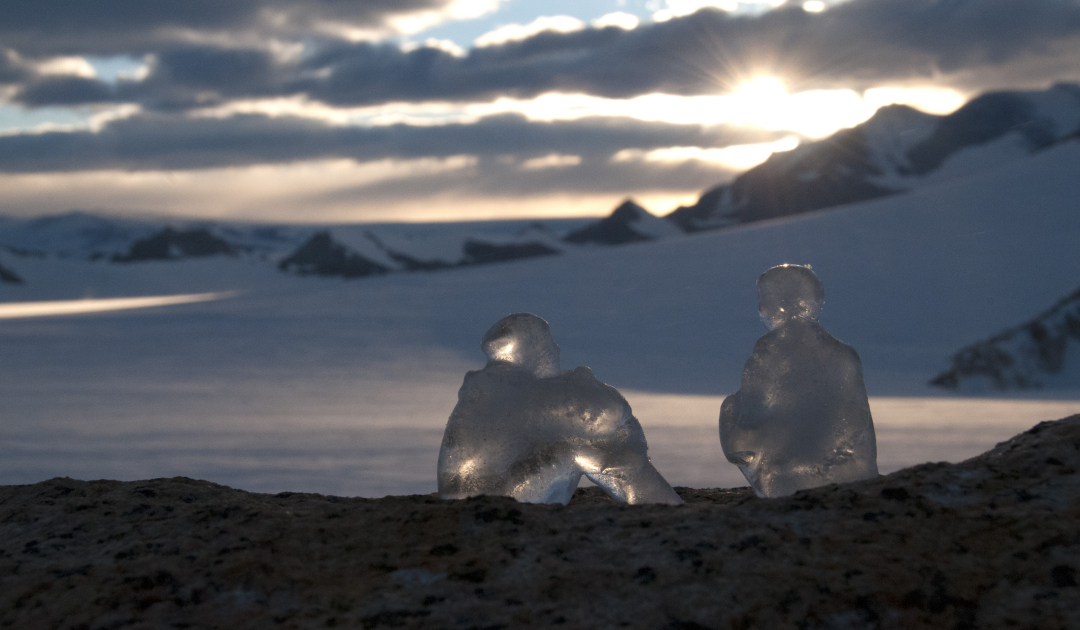
In the past, Antarctica has inspired numerous artists to create unique works. Be it musicians, painters or even sculptors, in all of them the imagination was stimulated by the unique landscape and conditions to create pieces of art. A very new and special project, however, does not focus on Antarctica, but was inspired by a story that took place tens of thousands of kilometers further north and has itself captured the imagination for thousands of years: the story of Penelope, the wife of the Greek mythical hero Odysseus (aka Ulysseus).
Captured in a painting in the icy world of Antarctica, two figures sit and contemplate the sun, which does not sink below the horizon in the Antarctic summer. They seem frozen in the moment, not by the cold or the image, but telling each other something and listening. Or a group of guests looking over a marked track from a hill to a pyramid-shaped mountain that stands near an Antarctic station, taking in the sight of the Antarctic landscape in the sunlight. All these figures are not real people, however, but ice sculptures by the artist Marie Minary, who initiated the “Pénélope” project and is now showing the result in an exhibition in Besançon, France.


The idea for the project came to her in 2017, Marie Minary explains in an interview. At that time, her partner Benoît Verdin, who is also involved in the project, had accepted a position at the Belgian Antarctic station “Princess Elisabeth Antarctica”. This research station, in operation since 2009, is located 180 kilometers away from the Antarctic coast in the middle of Queen Maud Land in East Antarctica. “At first, I had trouble accepting my partner’s impending departure. But I quickly realized that Benoît’s trip to Antarctica was a unique opportunity for both of us, for him to grow professionally, and for me to find inspiration as an artist.,” Marie Minary explains. From this occasion, the artist was inspired by the story of Penelope, wife of Odysseus, as she recognized many parallels in both their situations. Both of them cannot accompany their partner on his adventure, have to deal with his absence, have no possibility to influence his situation and cannot help either. Thus, she felt like an immobile statue with frozen expectations.
But unlike Penelope, who had to wait a total of 20 years without news of her husband’s return, the artist took the opportunity to get a picture of Antarctica through stories, photos from her partner and through literature. She recognized the two faces of the region: on the one hand, the harsh, unforgiving nature, shaped and influenced by the cold and remoteness. On the other hand, she also discovered the fragility of the region, which is increasingly negatively affected by climate change and time. Ice that looks so hard in Antarctica is being melted or eroded away by climate change and time. This, together with the connection to Penelope and her own feelings, gave birth to the project. The latter in particular is an equally important aspect of project development. Project “Pénélope” is an adventure, also a love adventure,” says Marie Minary. And on her website it says about the project “You took the light, I’m left with the night. The one we used to share. The same sky watches us. I offer you a window, a passage, so that we can continue to share our nights.”

The exhibition of the project “Pénélope” is a multimedia installation at the Museum of Art and Archaeology in Besançon. It features images and video footage of ice sculptures taken repeatedly in the light of the Antarctic sun over the course of two years. The play of light and shadow, of time and of single shots symbolizing the freezing of both figures and time are the central aspects of the installation. Together with the artist Maxime Vernier, Marie Minary developed the molds for the ice figurines, which she then gave to her partner Benoît to photograph and film in Antarctica. The footage was then edited at home and stitched together to create the art installation. “We accomplished my initial vision for the project in several discontinuous phases over two years,” Marie Minary continues.
After the pandemic prevented a first exhibition in April 2020, the installation has been on display since February 24 as part of a general exhibition of contemporary art in Besançon until April 24. But the project is not over yet, says Marie Minary. “It’s a continuously evolving project.” Besides, only a part of the whole project will be shown in Besançon. That is why more exhibition venues are still being sought. Let’s hope that it won’t take 20 years, as it once did in Homer’s “Odyssey”, until Project “Pénélope” is next seen.
Dr Michael Wenger, PolarJournal
Link to the website of Marie Minary and project “Pénélope
Link to the museum website
More on the subject:





